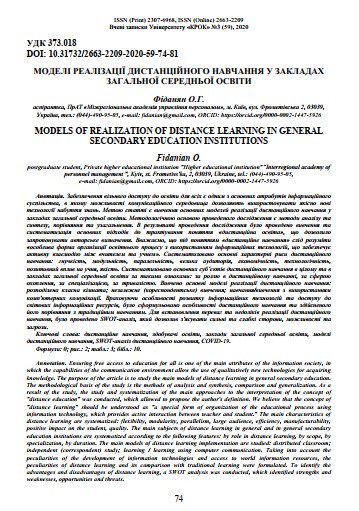MODELS OF REALIZATION OF DISTANCE LEARNING IN GENERAL SECONDARY EDUCATION INSTITUTIONS
DOI:
https://doi.org/10.31732/2663-2209-2020-59-74-81Keywords:
distance learning, students, general secondary education institutions, distance learning models, SWOT-analysis of distance learning, COVID-19Abstract
Ensuring free access to education for all is one of the main attributes of the information society, in which the capabilities of the communication environment allow the use of qualitatively new technologies for acquiring knowledge. The purpose of the article is to study the main models of distance learning in general secondary education. The methodological basis of the study is the methods of analysis and synthesis, comparison and generalization. As a result of the study, the study and systematization of the main approaches to the interpretation of the concept of "distance education" was conducted, which allowed to propose the author's definition. We believe that the concept of "distance learning" should be understood as "a special form of organization of the educational process using information technology, which provides active interaction between teacher and student." The main characteristics of distance learning are systematized: flexibility, modularity, parallelism, large audience, efficiency, manufacturability, positive impact on the student, quality. The main subjects of distance learning in general and in general secondary education institutions are systematized according to the following features: by role in distance learning, by scope, by specialization, by duration. The main models of distance learning implementation are studied: distributed classroom; independent (correspondent) study; learning / learning using computer communication. Taking into account the peculiarities of the development of information technologies and access to world information resources, the peculiarities of distance learning and its comparison with traditional learning were formulated. To identify the advantages and disadvantages of distance learning, a SWOT analysis was conducted, which identified strengths and weaknesses, opportunities and threats.
Downloads
References
Про вищу освіту: Закон України редакція від 25.09.2020, підстава - 849-IX. URL : https://zakon.rada.gov.ua/laws/show/1556-18#Text.
Концепція розвитку дистанційної освіти в Україні. URL : http://www.osvita.org.ua/distance/pravo/00.html.
Положення про дистанційну освіту : Закон України від 25.04.2013 р. № 466. URL : https://zakon.rada.gov.ua/laws/show/z0703-13#Text.
Васильченко Л. В., Шевченко В. Л. Дистанційне навчання: науково-методичне забезпечення; інформаційний простір навчального закладу. Харків : Основа, 2009. 208 с.
Яценко Г. Ю. Комунікативність в системі дистанційного навчання: фактори інтенсифікації: автореф. дис… канд. філос. наук: 09.00.10. АПН України; Інститут вищої освіти. Київ, 2008. 16 с.
Биков В. Ю. Дистанційний навчальний процес : навч. посібн. / за ред. В. Бикова та В. Кухаренка. Київ : Міленіум, 2005. 292 с.
Федорук П. І. Адаптивна система дистанційного навчання та контролю знань на базі інтелектуальних Інтернет-технологій: автореф. дис... д-ра техн. наук: 05.13.06. НАН України, Ін-т пробл. мат. машин і систем. Київ, 2009. 37 с.
Кухаренко В. М. Дистанційне навчання. Енциклопедичне видання: навч.- метод. посібник. Київ : «Комп’ютер», 2007. 127 с.
Яценко Г. Ю. Комунікативність в системі дистанційного навчання: фактори інтенсифікації : дис. ... канд. філос. наук : 09.00.10. Київ, 2009. 211 с
Кузьмінський А. І. Педагогіка вищої школи : навчальний посібник. Київ : Знання, 2005. 486 c.



